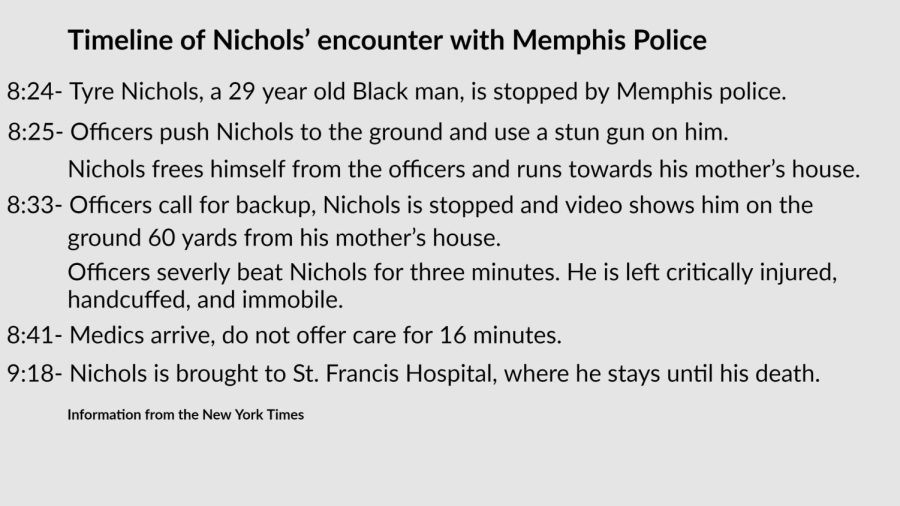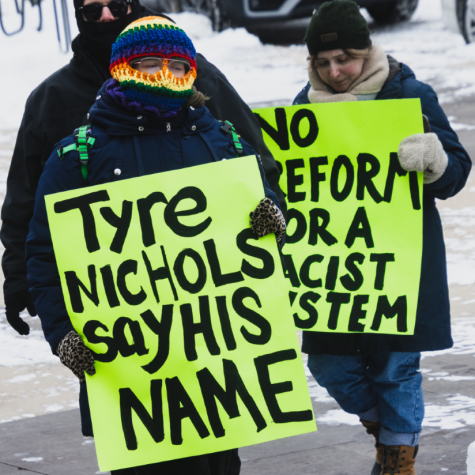Police reform returns to the Minnesota legislature after the murder of Tyre Nichols
Tyre Nichols was driving home after taking pictures of the sky when he was pulled over.
Memphis police officers beat Nichols, a 29-year-old Black man, for three minutes following the Jan. 7 traffic stop, causing severe bleeding that led to his death three days later. Nichols yelled for his mother as he was beaten 60 yards from her house.
The six officers involved in Nichols’ death have been fired and charged with felonies, but the nation still begs for justice. On Jan. 27, graphic videos showing Nichols’ beating were released and broadcasted across news sites. The video has spurred discussion around whether civil responsibility requires watching violent content, and the unsolicited prevalence of Black trauma.
“Posting violence, especially graphic violence, is hard to watch for many people, but that doesn’t make it unimportant,” sophomore Harper Glass said. “If you’re just watching your news and you see someone die, that’s pretty jarring, but people need to recognize what is going on and why and how it happened.”

The police officers that beat Nichols were part of the Memphis force’s Scorpion unit, a group of around 40 officers tasked with curbing violence in parts of the city with high levels of crime. According to Memphis residents, they often used excessive force, and turned encounters violent. The New York Times reported that 90% of the Scorpion unit’s arrests were Black, and the unit was three times as likely to use force on Black citizens than white citizens. Those familar with the unit said that Nichols’ abuse did not come as a surprise as the unit frequently used excessive brutal force for minor offenses.
“It’s pretty clear that he did not pose a threat to the police in any way. He wasn’t armed, he wasn’t striking or hitting the police,” Glass said of Nichols’ fatal encounter with Scorpion officers.
Nichols’ beating was not mentioned in the Scorpion unit’s police statement, but an involved officer sent pictures of Nichols’ beaten body to other officers and civilians.
After Nichols’ death, the Memphis police disbanded the Scorpion unit.

Nichols was a father, photographer, and skateboarder. His social media posts showed support for the Black Lives Matter movement, and called for changes in the police system. According to a close friend, Nichols recently considered joining the police force to create change from inside the system.
Tyre Nichols’ death reopens the wound of police violence known all too well in Minnesota, with the murders of George Floyd, Daunte Wright, and Amir Locke in the past three years. In May 2020, the death of George Floyd brought a national reckoning about race and police reform, a conversation that continues in the state legislature.
Police reform bills previously blocked by Republicans could return to the Minnesotan legislature now that there is a Democratic majority. Reforms include a ban on no-knock warrants, and changes in qualified immunity– a legal principle that protects government officials from civil lawsuits. Another significant piece of police reform is developing in the Board of Peace Officer Standards and Training (POST Board), the body responsible for licensing police officers. The proposed changed in the POST Board would make it so any officer suspected of misconduct could be investigated, rather than just convicted officers. Additionally, reforms would give the board power to revoke the license of an officer who witnessed misconduct and did not intervene and report it.
Junior Sam Murphy wants to see police reform legislation turn to law. “It’s a corrupted organization and they need to get better training,” Murphy said of the force.
In the aftermath of Nichols’ death, activism, questions and grief characterize the public’s response, all of which spill into political decision-making.
My name is Siri Pattison (she/her). I’m the Opinions Editor for The Rubicon Online. At school, I’m involved in the Antiracist Group, Student Activities...